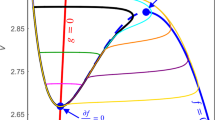Abstract
We studied the synchronous behavior of two electrically-coupled model neurons as a function of the coupling strength when the individual neurons are tuned to different activity patterns that ranged from tonic firing via chaotic activity to burst discharges. We observe asynchronous and various synchronous states such as out-of-phase, in-phase and almost in-phase chaotic synchronization. The highest variety of synchronous states occurs at the transition from tonic firing to chaos where the highest coupling strength is also needed for in-phase synchronization which is, essentially, facilitated towards the bursting range. This demonstrates that tuning of the neuron’s internal dynamics can have significant impact on the synchronous states especially at the physiologically relevant tonic-to-bursting transitions.
Similar content being viewed by others
References
Singer, W.: Synchronization of cortical activity and its putative role in information processing and learning. Annu. Rev. Physiol. 5, 349–374 (1993)
McCormick, D.A., Feeser, H.R.: Functional implications of burst firing and single spike activity in lateral geniculate relay neurons. Neuroscience 39, 103–113 (1990)
Mormann, F., Kreuz, T., Andrzejak, R.G., David, P., Lehnertz, K., Elger, C.E.: Epileptic seizures are preceded by a decrease in synchronization. Epilepsy Res. 53(3), 173–185 (2003)
Levy, R.: High-frequency synchronization of neuronal activity in the subthalamic nucleus of parkinsonian patients with limb tremor. J. Neurosci. 20(20), 7766–7775 (2000)
Baufreton, J., Zhu, Z.T., Garret, M., Bioulac, B., Jonson, S.W., Taupingon, A.I.: Dopamine receptors set the pattern of activity generated in subthalamic neurons. FASEB J. 19, 1771–1777 (2005)
Merello, M., Tenca, E., Cerquetti, D.: Neuronal activity of the zona incerta in Parkinson’s disease patients. Mov. Disord. 21(7), 937–943 (2006)
Silva, L., Blanes, F., Kalitzin, W., Parra, S.N., Suffczynski, J., Velis, D.N.: Epilepsies as dynamical diseases of brain systems: basic models of the transition between normal and epileptic activity. Epilepsia 44, 72–83 (2003)
Braun, H.A., Bade, H., Hensel, H.: Static and dynamic discharge patterns of bursting cold fibers related to hypothetical receptor mechanisms. Eur. J. Physiol. 386, 1–9 (1980)
Dutton, A., Dyball, R.E.J.: Phasic firing enhances vasopressin release from the rat neurohypophysis. J. Physiol. (Lond) 290, 433–440 (1979)
Atwater, I., Dawson, C.M., Scott, A., Eddlestone, G., Rojas, E.: The nature of the oscillatory behavior in electrical activity for the pancreatic beta cell. In: Malaisse, W.J., Taljedal, I.B. (eds.) Biochemistry and Biophysics of the Pancreatic Beta Cell, Hormone and Metabolic Research Supplement Series 10, pp. 100–107. Georg Thiem Verlag, Stuttgart (1980)
Dewald, M., Braun, H., Huber, M., Zwingmann, D., Roth, J., Voigt, K.: Interactions of temperature and angiotensin II in paraventricular neurons of rats in vitro. Eur. J. Physiol. 444, 117–125 (2002)
Sherman, A., Rinzel, J.: Model for synchronization of pancreatic beta-cells by gap junction coupling. Biophys. J. 59, 547–559 (1991)
Chow, C.C., Kopell, N.: Dynamics of spiking neurons with electrical coupling. Neural Comput. 12, 1643–1678 (2000)
Ermentrout, G.B.: Type I membranes, phase resetting curves, and synchrony. Neural Comput. 8, 979–1001 (1996)
Izhikevich, E.M.: Class 1 neural excitability, conventional synapses, weakly connected networks, and mathematical foundations of pulse-coupled models. IEEE Trans. Neural Netw. 10, 499–507 (1999)
Hoppensteadt, F.C., Izhikevich, E.M.: Weakly Connected Neural Networks. Springer, New York (1997)
Hansel, D., Mato, G., Meunier, C.: Synchrony in excitatory neural networks. Neural Comput. 7, 307–335 (1995)
Pikovsky, A., Rosenblum, M., Kurths, J.: Synchronization—A Universal Concept in Nonlinear Sciences. Cambridge University Press, Cambridge (2001)
Postnov, D.E., Sosnovtseva, O.V., Malova, S.Y., Mosekilde, E.: Complex phase dynamics in coupled bursters. Phys. Rev. E 67, 016215–016225 (2003)
Izhikevich, E.M.: Synchronization of elliptic bursters. SIAM Rev. 43(2), 315–344 (2001)
Belykh, V.N., Belykh, I.V., Colding-Jørgensen, M., Mosekilde, E.: Homoclinic bifurcations leading to bursting oscillations in cell models. Eur. Phys. J. 3, 205–219 (2000)
Hansel, D., Sompolinsky, H.: Synchronization and computation in a chaotic neural network. Phys. Rev. Lett. 68(5), 718–721 (1992)
Dhamala, M., Jirsa, V.K., Ding, M.: Transitions to synchrony in coupled bursting neurons. Phys. Rev. Lett. 92(2), 028101 (2004)
Xia, S., Qi-Shao, L.: Firing patterns and complete synchronization of coupled Hindmarsh–Rose neurons. Chin. Phys. 14(1), 77–85 (2005)
Bahar, S.: Burst-enhanced synchronization in an array of noisy coupled neurons. FNL 4(1), L87–L96 (2004)
Rulkov, N.F.: Modeling of spiking-bursting neural behavior using two-dimensional map. Phys. Rev. E 65, 041922–041930 (2002)
Wang, X.J.: Genesis of bursting oscillations in the Hindmarsh–Rose model and homoclinicity to a chaotic saddle. Physica D 62, 263–274 (1993)
Shilnikov, A., Cymbalyuk, G.: Transition between tonic spiking and bursting in a neuron model via the blue-sky catastrophe. Phys. Rev. Lett. 94, 048101–041930 (2005)
de Vries, G., Sherman, A.: From spikers to bursters via coupling: help from heterogeneity. Bull. Math. Biol. 63, 371–391 (2001)
Braun, H.A., Voigt, K., Huber, M.T.: Oscillation, resonances and noise: basis of flexible neuronal pattern generation. Biosystems 71, 39–50 (2003)
Rinzel, J.: A formal classification of bursting mechanisms in excitable systems. In: Gleason, A.M. (ed.) Proceedings of the International Congress of Mathematicians, pp. 135–169. AMS, Providence (1987)
Feudel, U., Neiman, A., Pei, X., Wojtenek, W., Braun, H.A., Huber, M.T.: Homoclinic bifurcations in a Hodgkin–Huxley model of thermally sensitive neurons. Chaos 10, 231–239 (2000)
Postnova, S., Nekrasov, A., Sosnovtseva, O.: Noise induced effects in dynamics of coupled bursters. Proc. SPIE 5696, 183–192 (2005)
Postnov, D., Han, S.K., Kook, H.: Synchronization of diffusively coupled oscillators near the homoclinic bifurcation. Phys. Rev. E 60(3), 2799–2807 (1999)
Author information
Authors and Affiliations
Corresponding author
Rights and permissions
About this article
Cite this article
Postnova, S., Voigt, K. & Braun, H.A. Neural Synchronization at Tonic-to-Bursting Transitions. J Biol Phys 33, 129–143 (2007). https://doi.org/10.1007/s10867-007-9048-x
Received:
Accepted:
Published:
Issue Date:
DOI: https://doi.org/10.1007/s10867-007-9048-x




